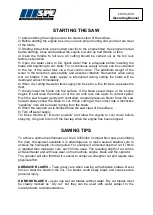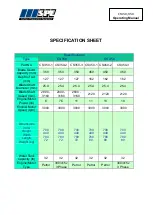
CS350/450
Operating Manual
STARTING THE SAW
1/ before starting the engine ensure the blade is clear of the surface.
2/ Before starting the engine be sure you have proper footing and your feet are clear
of the blade.
3/ Starting instructions are provided specific to the engine fitted. See engine manual
before starting. Once started allow the engine to warm up half throttle or less.
4/ Open the throttle to full revs. All cutting should be carried out at the full revs
factory set position.
5/ Open the water valve to full, check water flow is adequate before lowering the
blade and beginning to cut. Note: For a continuous supply a hose can be connected
to the top of the water tank via a flow control valve. The additional weight of the
water in the tank then aids stability and absorbs vibration. Remember when using
wet cut blades if the water supply is interrupted during cutting the blade will be
destroyed almost immediately.
6/ When dry cutting the water tank supply can be set to a fine trickle to suppress the
dust.
7/ Slowly lower the blade into the surface. If the blade speed drops or the engine
begins to stall raise the blade out of the cut until revs rise again to correct speed.
Push the saw forward gently with controlled, constant pressure. Never force the saw
forward always allow the blade to cut. When cutting at the correct rate a distinctive
“swishing” note will be heard coming from the blade.
8/ When the required cut is finished raise the saw clear of the surface.
9/ Turn off water supply.
10/ Move throttle to “tick-over position” and allow the engine to cool down before
stopping. It is good to turn off the fuel tap when the engine has been stopped.
SAWING TIPS
To achieve optimum performance of the CS350/450 Compact floor saw and utilising
the (low) horsepower available it is advantageous to make several shallow cuts to
achieve the final depth of cut required. For example if a finished depth of cut if 70mm
is required then make two cuts, each 35mm deep. The resulting depth of cut will be
achieved faster and with less wear on the machine, engine, blade and the operator.
The operator will also find that it is easier to achieve a straighter cut and require less
physical effort.
ABRASIVE BLADES
–
Take great care when sawing with abrasive blades. Never
force or twist the blade in the cut. The blades could easily break and cause severe
personal injury.
DIAMOND BLADES
–
never use wet cut blades without water. Dry cut blades must
be clearly marked as “Dry cut” but they can be used with water subject to the
manufacturers recommendations.





















